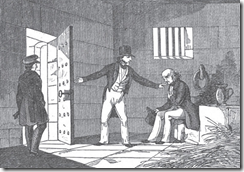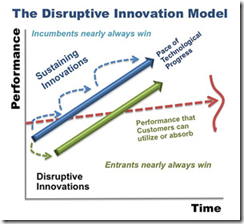 Does dealing with credit reporting agencies feel like shackles on the economy? Is consumer-benefiting innovation in credit reporting near zero? Does the current system add friction to economic stimulation measures? Has the current system evolved into a modern debtor’s prison preventing many from contributing to an economic recovery?
Does dealing with credit reporting agencies feel like shackles on the economy? Is consumer-benefiting innovation in credit reporting near zero? Does the current system add friction to economic stimulation measures? Has the current system evolved into a modern debtor’s prison preventing many from contributing to an economic recovery?
I’ve written about disruption, innovation and looking for difficult problems to solve. Seems logical to call out a few obvious targets and frame it as difficult problem with profound disruptive potential for innovation.
The consumer credit reporting industry is a good target for disruptive innovation. It’s owned by a powerful few, driven by legacy and built for the industrial era. It shackles consumer spending reducing the effect of economic stimulation measures.
Why should I make a call for disruptive innovation? Why not? Why not you, too?
Disruption, Innovation, Credit Reporting
Clayton Christensen describes the difference between sustaining (incremental) innovation and disruption innovation. Sustaining innovation adds incremental features and capabilities to a product and service. Disruptive innovation dramatically changes a product or service to be much simpler and more affordable than the current solution everyone relies on.
The transformative nature of these changes increases access the product or service making it available and useful to significantly more people.
People and Economics
I believe in people, and their ability to learn and grow from past experience. I don’t think it takes the proverbial seven years to learn, however. I also see a complete disruptive overhaul of the credit reporting industry as an opportunity for people and the economy to benefit.
An industry disruption could take credit reporting out of the hands of a few (three) powerful companies that have become complacent. The social era distributes that power to the consumer who in the end (should) own and control their credit data. What happened seven years ago is really not relevant – it never was relevant, we just allowed the powerful to control us, through fear.
Other Factors Make this Ripe Opportunity
Unique to this call for innovation, there are a number of other factors that make this a much more ripe opportunity for disruptive innovation than usual.
First, consider the forces of economics, and the government, international finance, global market, and business events of the past five to seven years. Who is not aware of the collapse of consumer credit markets driven by questionable derivative markets and their collapse?
Second, understand that credit scoring should use rolling real-time statistics and analytics on a consumer’s most recent credit behavior. Instead, it is an amalgamation of years of behavior that is likely a poor indicator for a consumer’s future creditworthiness. What was forced on consumers in the past five years of economic decline should not be an extended punishment for offenses individuals did not commit – just because the antiquated industrial era rules say so.
Third, know that bankruptcy is economic recovery and contribution. We replaced the debtor’s prison with the gift of a second chance built into the system as a virtue, not a crutch or crime. Yet current creditworthiness looks at bankruptcy as a liability when it may well be a sound decision. In the last five years, many were forced down this path by economic forces not in their control. Their creditworthiness was based on employment and losing their job is not bad credit behavior.
Finally, look to technology. We now have pervasive mobility, the cloud, big data and prescriptive analytics within integrated information systems. The opportunity to put creditworthiness control into a real-time app on one’s smartphone in real time should be a tool everyone has at their fingertips. The current process for engaging with credit reporting institutions and their tool set is too expensive, time consuming and difficult to use and access by the majority.
Simply put, the current legacy system is universal friction preventing the consumer from contributing to economic recovery.
Real Time Credit Information System
These four concepts alone should drive the thinking necessary to begin to deliver on this idea. Spend no time collecting and managing data. Other groups including the current credit reporting agencies have perfected that aspect. Focus instead on utility, free or low-cost business models, privacy concerns, and disruptive thinking to provide access to a larger population.
- Integrate accurate immediate data to measure consumers’ behavior and responsible use of credit in real time.
- Feedback notification to consumers about their behavior and tools to ensure they don’t become over-extended, in real time.
- Control of privacy and exposure of credit history and information simply, efficiently, and with confidence.
- Consumer access to an immediate and accurate report of their credit information in real time.
- Merchants access to real-time perspective of a consumer’s credit habits right now to reduce friction and enable a transaction.
Customer Service and User Experience
Credit reporting agencies do not provide customer service. They do not answer the phone. They are not wired to support or provide a service to consumers. Nothing gets done unless it is submitted in writing. Then it’s weeks, or longer before a written, often computer generated standard response is received.
This is because there are few people at these companies. They are wired to control information and reduce risk for the creditors that access their information. The people they have are focused on keeping the systems and process status quo.
Little attention is given to innovating and building a better system. Even less attention is focused on customer service, and improving the consumer experience. Consumer credit pulls up an economic downturn; and therefore it’s ironic to see this much friction in the credit enabling system.
Is this an industry ripe for innovation? Absolutely!
To Ponder
Who will be the disruptor? Who will combine these market forces, design and build the next, better, more effective agile system that equally serves the debtor and the creditor? Who will take on the challenge, now that current knowledge shows that disruptive incumbents nearly always win? Who will recognize the opportunity to make the profound contribution to consumers? Who will see this as the opportunity to drive economic growth by reducing friction in the market, and helping people improve their quality of life through responsible use of their creditworthiness?
Five smart entrepreneurs with KickStarter crowd funding are at a great advantage to innovate over the current system and institutional model.
The challenge has been framed. Please leave a comment.
Image Credits: Disruptive Innovation Model: Innosight, Col. Johnson Liberating an Unfortunate Debtor, from A biographical sketch of Col., Richard M. Johnson, of Kentucky, by Asahel Langworthy, 1843. 19th century handcuffs, the Bedford Museum. Debtor prison and handcuffs image collected from Wikimedia Commons, and are in the public domain.










[…] Disruptive innovation in credit reporting is unshackling. Moving out of the industrial era, into the real-time social era with mobile and big data? (Archives: Unshackling. […]
You’d have thought the entire credit rating industry — consumer and institutional — would have been brought down by the 2008 collapse. After all, the geniuses who awarded A+ ratings to mismanaged bundles of sub-prime loans were in no small part responsible for the meltdown.
Ahhh, yes, Jeff. One would think. However, what would have replaced it?
Short of letting my entire product specification, disruptive business model and entrepreneurial solution out of the bag – I am anticipating that this discussion spark a wiser actuarial innovator than I to come forth.
I would not expect any brilliant re-invention of how we rate credit behavior coming from within the industry, ever. Why would it? there is no incentive or competition for them to change. The big three use pretty much the same algorithm to come up with nearly the same historically-focused “rating” so much that the last time I refinanced, the bank really didn’t even look.
The point driving innovation here is that a real-time credit-behavior rating is more valuable than what one did in the entire 7 years prior. Paying back a loan is in the future. One needs to set systems in place to enable the future to be achieved as expected. The past has nothing to do with that in the social era.
Looking forward to your next blog ! on “we’re not expecting any surprises.”
Cheers,
Andrew